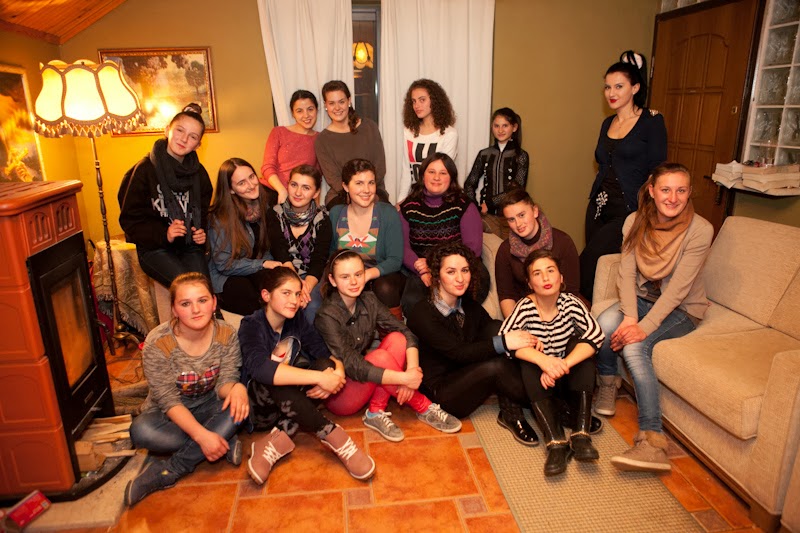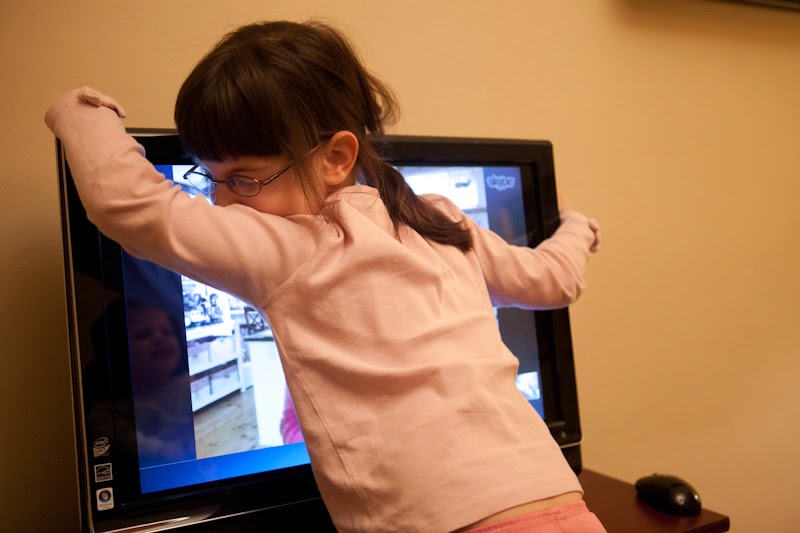Tonight he did it. He screwed up his courage and he did it. Nathan ordered pizza over the telephone. And not in English. At MTI they challenged us to simple, yet terrifying tasks such as this. I'm a tad embarrassed we didn't try this sooner. But tonight we were hungry (no new groceries 'til tomorrow) and didn't want to delay our supper any longer than necessary.
So how did he do? We'll share the results at the end...
Probably one of the most common questions we got on the road last year was this:
what language do they speak in Albania?
Don't worry. It didn't annoy us. We love talking about Albania and this question only served as a great conversation starter.
The answer to that question is
Shqip (or,
Albanian).
One of our readers (okay, my sister) asked if I might share a little of what we're learning in Albanian class. I was actually relieved to get her request because I've really been wanting to share here. It's been so challenging, and hard, and frustrating, but also rewarding. We love class, we love learning, and we love that we get to implement what we learn right away. Here's how we're doing it...
Regimine
We've been in class since early October and have supplemented our classroom learning with three additional lessons per week with our language helper, Vera, using the language acquisition exercises (LAPs) we learned at MTI. The two different approaches, in addition to individual study, have complemented each other well, but I don't know that one ever feels like he is doing 'enough'. In addition to morning study sessions five days per week, Nathan has been reviewing some basic Albanian through Pimsleur exercises while folding laundry or washing dishes and we like to try to catch the news via Top Chanel live streaming on the computer (we still haven't gotten around to getting a TV yet!).
Style of Learning
Our instructors at MTI shared that new language acquisition comes much like we all acquired our first language, in a very specific order: months and months of
listening (comprehension) before eventually
speaking, followed by
reading those words we have heard for so long, and finally,
writing. Too much emphasis on
speaking at the beginning of the acquisition process (part of the traditional classroom approach) only triggers fear and frustration on the part of the learner, which close the "learning gates" of our mind because the learner is usually forced to speak before he is ready.
This sequence of listening/speaking/reading/writing is utilized in our LAPs where we hear basic vocabulary and statements by Vera long before we ever begin mimicking her words and phrases and it's not until near the end of the exercise that we even see these new words written down (
our connection to Albanian words is to first be audible and contextual for the new words to come into our heads more naturally and 'just sound right'). The idea is that the learner avoids the process of 'translation' (an extra step in the brain to slow us down) but rather unconsciously thinks '
another way to say that is...'. So when we make vocab flashcards, when at all possible, we use pictures and Albanian words, avoiding English altogether if possible. E.g. a photo of Toto on one side, the reverse reads "qen" (
dog).
Of course I mentioned that we are taking a class which uses a more traditional, academic approach. After my dad visited last month, he pointed out that we are learning with some pretty bright minds. For over half of our class, this is at least their 3rd or 4th language to learn. They find themselves in Albania because they bring skill sets not easily found in this country... so you get the idea. They are already top drawer for the nations they come from. In other words, to keep up with our classmates, we have to be diligent! Thankfully we have a very patient and understanding teacher whose approach 'keeps our learning gates open.'
Background
It surprises many to learn that Albanian -- while rooted in the ancient Illyrian language -- has only had a standardized alphabet since 1908. It has a number of words borrowed from other languages, but according to the experts, it sits on its own branch apart from all other European languages. Albanian speakers can be found in neighboring countries like Greece, Macedonia, Kosovo, and Montenegro.
The Alphabet
Thankfully Albanian uses a Latin alphabet with only two characters we don't have in English (e pica - ë, and what we casually call a 'c-tail' (sounds like 'ch' and looks like ç). Each letter of the alphabet has 1 unique sound (nothing of this c
as in cat or c
as in Cecilia or receive). this makes reading Albanian pretty straight forward once you know the phonics and have mastered the dozen or so sounds that we don't have in English. A lot of them require that we exercise those lazy American lips of ours -- yes, we were told Americans are known world wide in linguistic circles as having "lazy lips!". Confused? Watch a YouTube of an African saying Coca Cola and watch yourself in the mirror say the same word... go ahead. We'll still be here.
The alphabet also contains a number of digraphs (two consonants together that make a unique sound) which represent their own character in the alphabet, like gj (like if you were to mash together the words jello and yellow), nj (as in njoh that sounds like no + yo and means to know), dh (sounds like th as in
this or
that, not 'th' as in
thistle), xh (sounds like j as in Jenny), sh, zh, etc.
Digraphs were initially confusing for us is when it came to alphabetizing or looking up words in the dictionary. For example, the word
sofra comes BEFORE the word
shtepi in the dictionary because
sofra starts with 's' that comes before 'sh', the first character in 'shtepi'. All words starting with sh (of which there are many) are in their own section of the dictionary.
So those are some alphabet characters Albanian has which we don't have in English. One character they notably
don't have is "W" -- something we obviously noticed early on! It took me a second to realize (when talking about nations and capitals) that
Uashington was actually Washington DC.
Grammar Intro
I won't get into the nitty gritty of this but Albanian has some
notable differences from English.
The first is the way they distinguish '
definite' from '
indefinite'.
For example, it's one thing to say, "Give me
an apple" vs. "Give me
the apple". The first is indefinite, the latter is definite.
Albanian doesn't use articles, they just change the ending of the word to distinguish between definite and indefinite.
And to know
how to change the ending of the noun, one must first know its
gender (something else we don't have in English). And there really is no standard rhyme or reason why a noun is a particular gender. Like the word for 'dress' is
fustan, which is masculline! ;-) When all else fails, assume it's masculline, we've been told! But gender is important because
Albanian doesn't have the pronoun "it", so you refer to every object by its appropriate gender pronoun, he or she, even if it is inanimate.
For example:
I wore a coat today. Can you go get him for me?
Albanian also has
cases. If you have studied other languages, you might be familiar with this concept. Albanian has SIX. One of the more 'unusual' cases is called Admirative. It's a change in the verb form to show surprise. I won't go into cases because we haven't really done more than scratch the surface in class yet.
 |
| Nathan and I bought this as a Christmas gift to ourselves. |
Verbs
Oh don't get us started on verbs.
Did you know there are 164 variations of the Albanian word that means "to come"?
There is generally a stem word for each verb and the ending changes depending on if the subject, tense, and case. Though it's not always the ending of the word that changes, but the entire word itself. But because it's assumed that you know all the verbs and their various forms, the subject pronoun is frequently dropped altogether from the sentence with the expectation that the listener can
infer the subject from the form of verb used.
I could write the sentence, "I am American" as
Unë jam Amerikanë. But Albanians would think that's an unnecessary waste of breath or ink and say/write the sentence as "
Jam Amerikanë."
But to write the sentence,
"He is American." I could write "Ai është Amerikan" or more concisely (remember, no wasting!),
"Është Amerikan." And I know that the sentence translates "he" and not "she" (though they both use the same verb for 'is', "është") because of the masculine ending of "Amerikan." To say
"She is American." I would have written,
"Është Amerikanë." And lest you say, "Oh! That's easy. The feminine has an extra vowel at the end!" Except... when it's spoken, that vowel is SILENT! So you can't 'hear' the difference unless you understand and remember the subtle nuance of syllabic emphasis (which to my ears, are super subtle) to distinguish the two!
There are three general categories of verbs which follow their own set of patterns for word endings, but for the most part, the conjugations just have to be memorized!
Below are all the ways to say "come" in all the tenses and cases.
So how did Nathan's pizza order get interpreted?
When Nathan called Tito's he asked for two pizzas. One with ham and onion, the other plain cheese.
When Nathan arrived at Tito's, the baker was apologetic that our order wasn't finished since he could only bake two pizzas at one time in his small oven. Nathan was confused for a moment before it dawned on him that that the pizza guy mistakenly thought we wanted TWO ham and onion pizzas and one cheese.
He kept telling Nathan, I could have delivered so you didn't have to wait!
Giving directions to our apartment? It's confusing enough in ENGLISH! Giving directions in ALBANIAN??? That will be our next challenge. And you'll know we mastered it when you see a photo here of Nathan with his arm around Tito on our apartment landing, but not tonight! Sonte ne do të hamë!
Tonight we will eat!


















































